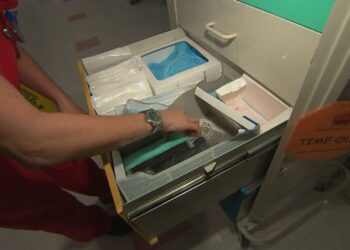WASHINGTON, D.C. – A rare, eight-foot flower known as the “Corpse Flower” is attracting Washington D.C. locals and tourists. The U.S. Botanic G said it’s a unique and smelly experience seeing this plant in person.
Taking center stage at the U.S. Botanic garden in Washington D.C., this roughly eight-foot-tall plant is attracting more than just pollinators.
“This is technically an inflorescence which is a collection of flowers,” said Stephen Jones, an arborist with the U.S. Botanic Garden. “We sort of consider this like the panda bear of the plant world. This plant is just big and cool and it always attracts attention.”
It’s nicknamed the “Corpse Flower” and it smells just like it sounds.
“I would I would say it’s like a big pile of dirty diapers, combined with maybe a dead mouse or something like that,” said Jones. “It’s pretty, pretty awful.”
It took nine years for this plant to bloom and when it does, you have a short window to see and smell and even feel the heat coming from this plant. A time lapse shows just how quickly the flower blooms and then closes right back up.
“This plant blooms infrequently,” said Jones. “It blooms over a 24-to-48-hour period and its fascinating both in its size and its stench and some of the characteristics it has its able to produce heat, it’s thermogenic. They heat up at night which is really neat. The spadix in the center just in this example, the room was 70 degrees at night when this bloomed that was here at midnight and the spadix exceeded up to 90 degrees which is really neat.”
“As you can see by the time we got here, we just missed the plant at full bloom but arborists said not to worry because they have one-hundred of them here at the Botanic Garden as part of their conservation program. Within the next couple of months, others could bloom at any moment.
“It always attracts attention even if you’ve seen it before,” said Jones. “It’s cool every time.”
The plant is originally from the island of Sumatra in Indonesia. Today there are less than a thousand in the wild due to logging and changing the plant’s native forest habitat to oil palm plantations, making it an endangered plant. Officials at the U.S. Botanic Garden said they saw a huge spike in visitors when that smelly plant was blooming and they expect more visitors when another Corpse Flowers bloom relatively soon.















